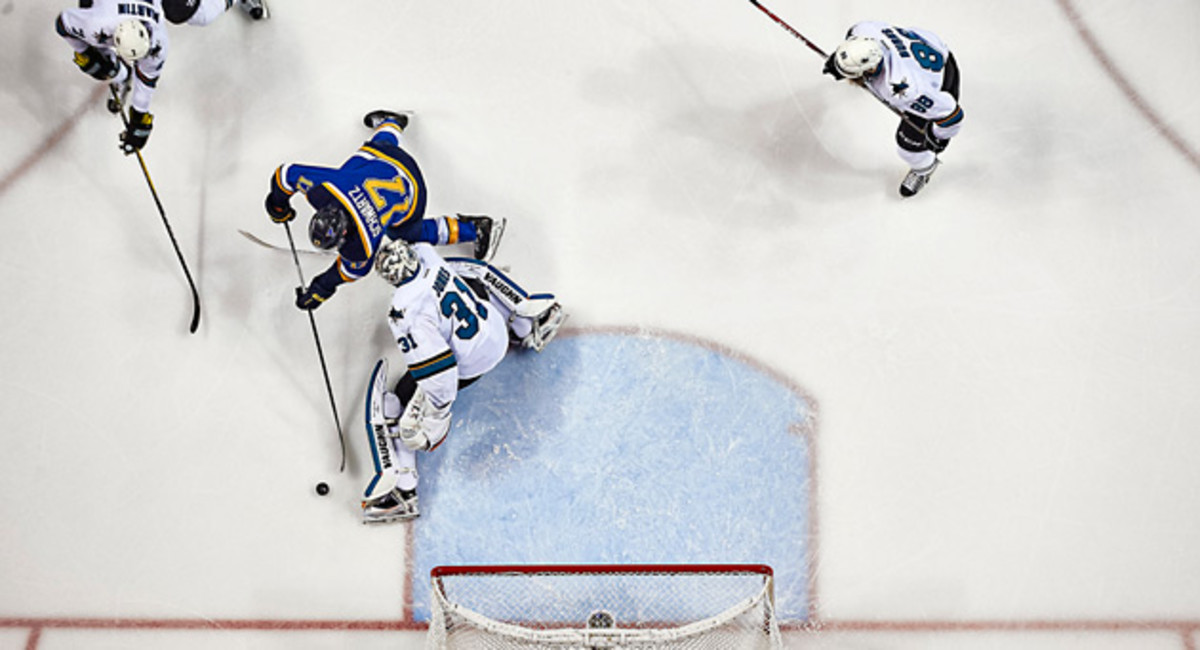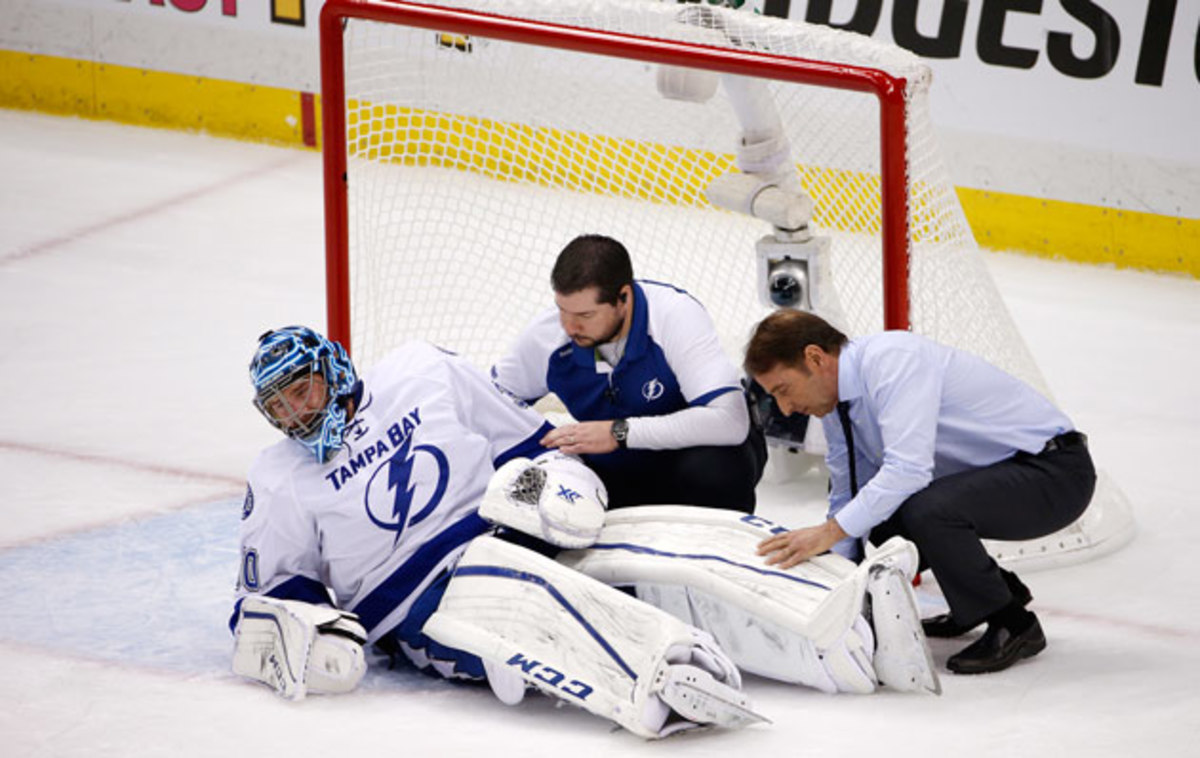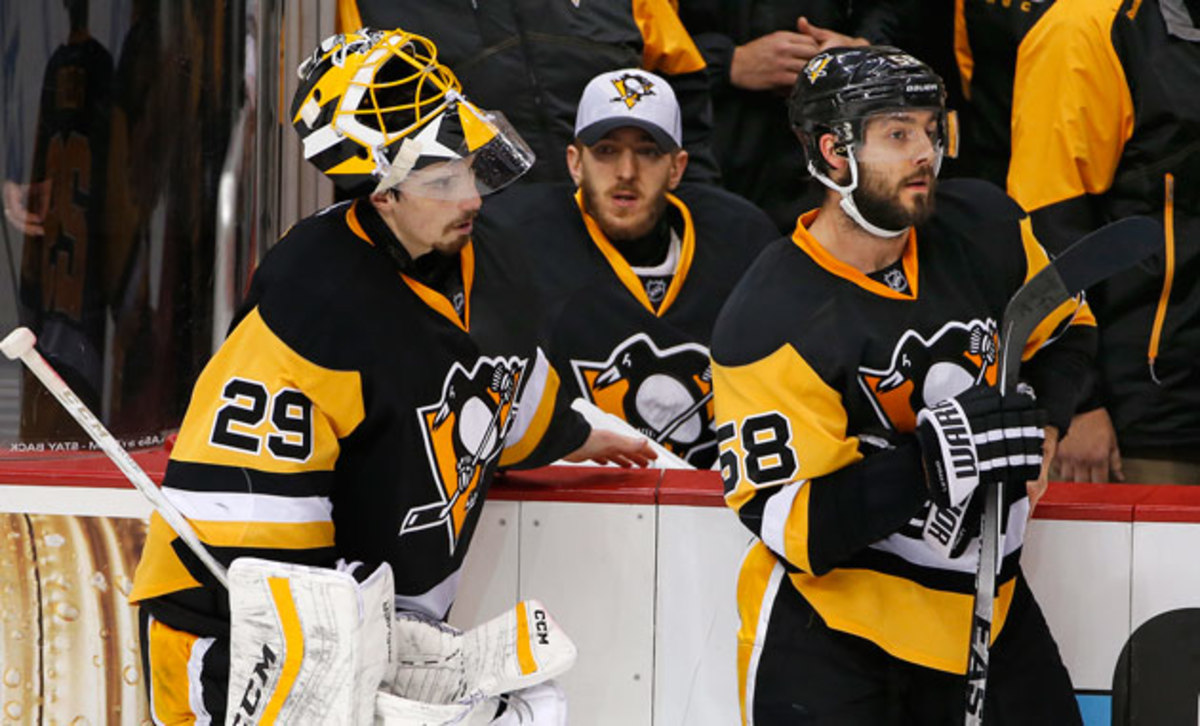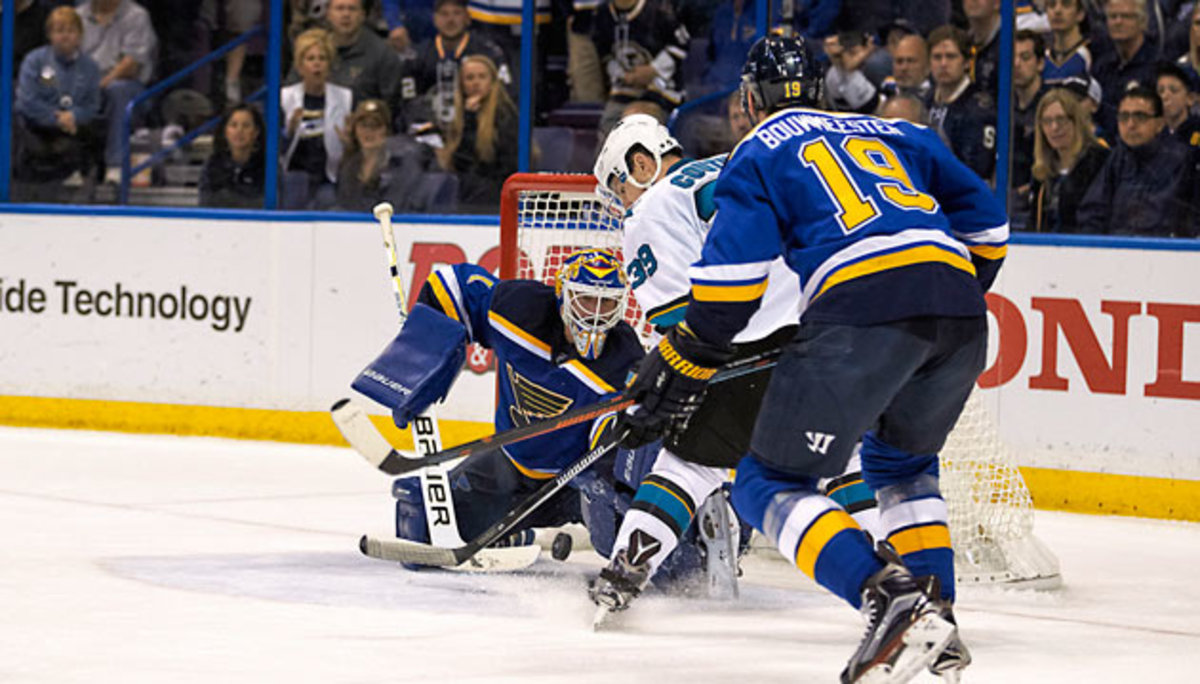The Replacements: Workhorse goalies no key to long playoff run in 2016

This story appears in the May 30, 2016 issue of SPORTS ILLUSTRATED. To subscribe, click here.
Get all of Alex Prewitt’s columns as soon as they’re published. Download the new Sports Illustrated app (iOS or Android) and personalize your experience by following your favorite teams and SI writers.
Midway through the second period in Game 4 of the Western Conference finals, Sharks goaltender Martin Jones plopped onto the home bench at SAP Center, removed his mask and slipped on a black baseball cap, done for the night after the Blues scored on him for the fourth time. Across the ice, as backup James Reimer wiggled and warmed up in the crease, a strange subplot of these 2016 Stanley Cup playoffs kicked into reality: With Reimer’s entrance, each of the four teams participating in the conference finals had used two goalies during the series, a revolving door unseen since 1980, a decade before Jones was born.
One of the swaps was a medical necessity. For the second straight postseason Tampa Bay coach Jon Cooper was forced to turn to Russian youngster Andrei Vasilevskiy, this time when starter and Vezina Trophy finalist Ben Bishop suffered a leg injury in Game 1 of the Eastern Conference finals. But the other net changes were more complicated, more likely to result in bruised egos than stem from bruised ribs. Opposite the Lightning, the Penguins sent Matt Murray to the bench after the second period of Game 4; the rookie, who got the job when starter Marc-André Fleury went down with a concussion in March, had carried Pittsburgh through two rounds but gave up 11 goals in as many periods against Tampa Bay. After the Blues lost two of the first three games against San Jose, coach Ken Hitchcock bumped Brian Elliott in favor of Jake Allen, hoping to spark what he called “a little bit of a momentum change.” And when St. Louis, which had scored just twice in Games 1 through 3, jumped out to a 4–0 lead in Game 4? Sharks coach Pete DeBoer assigned Jones a seat at the end of the bench.

No wonder Panthers netminder Roberto Luongo, no stranger to the roller-coaster ride that is goaltending during the Stanley Cup playoffs, tweeted Sunday, along with a GIF of a shrieking Oprah, “YOU get a start! YOU get a start! EVERYBODY gets a start in the conference final!!!!”
Conventional wisdom holds that in the name of stability, teams must ride a No. 1 netminder through the playoffs. Of the past seven Cup winners, only one—the 2015 Blackhawks, with minor league journeyman Scott Darling replacing Corey Crawford for performance-related reasons in the first round—had multiple goalies win more than one game. But this year has birthed a new truism, indicative of the increasingly short leashes given starters at this time of year: Backups, be ready. “You need two goalies to get this far,” Bishop says. “There’s more parity. Goalies are getting better every year.”
Need further proof? Look more closely at Pittsburgh and Tampa Bay, where two netminders barely old enough to sip celebratory champagne carried their teams to within sniffing distance of doing just that.

A DECORATED PROSPECT prospect who before his 20th birthday had already won three world junior championship medals and gold at the 2014 worlds, Vasilevskiy reported to the AHL’s Syracuse Crunch in September 2014 with an intense daily routine that quickly turned heads. Teammates were surprised to learn that he had bought a treadmill to use at his home. “We’d come in for practice and he’d already be sweating, finishing a workout,” says Mike Angelidis, Syracuse’s current captain. “I remember being like, Hey, maybe you should take it easy. He understood, but he didn’t really listen to us.” Through four starts the grueling playoff pace hadn’t slowed him down either. Before Game 5 in Pittsburgh, Lightning teammates stepped off the bus to find their starter already pedaling a stationary bicycle while tossing a rubber ball against a brick wall to hone his hand-eye coordination. “Just be ready, not come in five minutes before and [say], What I have to do?” is how Vasilevskiy explains his approach. “No, I like to be at the rink two hours before and do my stuff.”
This overwork ethic was interrupted this season when doctors found a blood clot around his clavicle, the apparent result of an off-season workout that pinched a vein against his collarbone. The ensuing surgery in September involved removing a rib and left a slim scar, along with the resolve to return quickly. “There was not a day he came in with a lip and a poor me,” Lightning goalie coach Frantz Jean says. “That says a lot about the kid.” Back in action by Nov. 1, Vasilevskiy played sparingly behind Bishop and was sent to Syracuse on five separate occasions during the season to stay fresh, reassignments that were frustrating for reasons beyond hockey. On New Year’s Eve, Vasilevskiy learned about the birth of his first child back in Tampa Bay while on a Crunch road trip. But two days later Vasilevskiy was back with the Lightning, making 30 saves in what would become the second of five straight wins, a personal-best streak.
How NHL goalies deal with playoff pressure between the pipes
This all steeled Vasilevskiy for the events of May 13. In the first period of Game 1 against Pittsburgh, Bishop fell awkwardly onto his left leg while trying to make a save; he writhed in pain as a stretcher wheeled him away. With Bishop in the hospital, Vasilevskiy faced 26 shots, stopped 25 and became the first goalie in two decades to pick up his first two playoff wins in relief, having gotten one in last year’s Cup finals when Bishop suffered a torn groin. “He’s a mentally strong kid,” the 6' 7" Bishop said later, a few days after MRI results revealed no structural damage to his leg. “He’s staying big out there.” Coming from the tallest goalie in NHL history, this speaks volumes.
The Lightning hardly made life easy for their backup. Vasilevskiy faced 127 shots on goal in Games 2 through 4, including a whopping 48 in Game 3, the most ever allowed by Tampa Bay in a regulation playoff game. But his .921 save percentage during that stretch helped keep the Lightning even with Pittsburgh, and 31 more stops in Game 5 brought his team to within one victory of a second straight trip to the finals. “A lot of guys at his age, under the pressure of the playoffs, suddenly there’s a little bit of panic, then the uncertainty comes in, then you start doing things you’re not supposed to do,” Jean says. “Well, Vassy’s on the opposite side of the spectrum.”
Of course, the same could have been said about the other youngster in the opposing dressing room.

THEY CHECKED into the Ritz-Carlton and opened the door to an unknown world. It was Dec. 15, the day Murray and forward Connor Sheary arrived in Boston for their first NHL assignments. The five-hour drive from Wilkes-Barre, Pa., home of the Penguins’ AHL affiliate, had passed in silence. They spoke little about what awaited them, instead watching movies on their iPads and listening to music in the chauffeured SUV. One look at a hotel room far swankier than anything they’d seen in the minors made it clear that things had changed for them. “That was the aha moment,” Sheary says. “We realized, Wow, we’re in the NHL right now.”
It took four months for Murray to justify his promotion. He played well, if intermittently, winning five of his first eight starts. But with Fleury suffering a concussion against Nashville on March 31, Murray started four of the last five games of the regular season and then shepherded Pittsburgh past the Rangers in the conference quarterfinals. He ceded just one goal in Games 3 and 4 combined and became the youngest netminder since 2009 to earn a 30-save playoff shutout. But his crowning moment came in Game 3 of the second round against the Capitals, this season’s runaway Presidents’ Trophy winners. In turning aside all but two of 49 shots, Murray changed the course of the series. “He’s the real deal,” says Capitals defenseman Taylor Chorney, an ex-teammate in Wilkes-Barre. “I don’t think there’s any denying that.”
History not on side of goalie tandems in Stanley Cup hunt
Born 61 days before Vasilevskiy in 1994 and drafted 64 spots after him in 2012, Murray reached the NHL with slightly less pomp than his Russian counterpart, who was selected at No. 19. During his second year with the OHL’s Sault St. Marie Greyhounds, his NHL central scouting ranking tumbled from No. 2 among North American goalies at the midterm to No. 18 by April, thanks to the Greyhounds’ midseason acquisition of Jack Campbell, who overtook Murray for the starting job. Sure, Murray eventually shattered the AHL’s consecutive-shutout mark by almost 36 minutes last season, but he had only gotten the opportunity because All-Star Jeff Zatkoff had been sidelined with a lower-body injury. “I’d seen him in practice, and I wasn’t totally sure,” Chorney says. “Then he came in and right away was breaking records.”
Teammates and coaches believe Murray’s resilience comes from a laid-back, almost ordinary personality, atypical of the eccentricity often associated with the position. “It’s almost like you had to tell a defenseman to go check him for a pulse,” said Colin Zulianello, who has trained Murray at his Ontario goalie school. During timeouts Murray often wanders to the bench to chat, praising teammates for strong defensive plays. When he and Sheary room together on the road, the television tunes not to NHL Network but to HGTV. Until recently, he might’ve been mistaken anywhere for another scrawny 6' 4", 178-pound college student with acne dotting his cheeks.
His calm was most apparent midway through the third period of Game 3 against Washington, with Fleury medically cleared but backing up because of Murray’s success. As Pittsburgh led 3–1, Capitals winger T.J. Oshie whirled along the goal line and shoveled a backhander from close range. Tracking the rebound to the other side of the crease, Murray pinched against the post, allowing no room for Alex Ovechkin’s two follow-up attempts. And as a frustrated Ovechkin hacked at Murray’s pads like a lumberjack, even after the whistle blew, Murray stayed still. This was his moment. He wasn’t going anywhere . . . until he was.

WHEN THE Penguins emerged from the tunnel before the third period of Game 4 against the Lightning, Fleury, not Murray, led the procession. Two unstoppable strikes from Tampa Bay shooters and two bounces that Murray later called “absolute horses‑‑‑” had dumped Pittsburgh into a 4–0 hole, so Penguins coach Mike Sullivan returned to his seasonlong No. 1 for a jolt. Murray was animated while yoked to the bench, leaping from his seat as the Penguins mounted a furious rally that ultimately fell short. Later, in the locker room, he downplayed the notion that he had lost the job for good. “It’s not my place to say anything about that,” he said. “That’s Coach’s decision.”
Two nights later in Pittsburgh, Murray again served as the backup for Game 5, watching first as the crowd celebrated Fleury’s return—In goal . . . welcome back . . . number 29 . . . [unintelligible roars]—and then as Fleury allowed four goals on 25 shots, including Tyler Johnson’s game-winner 53 seconds into overtime. After, Sullivan again fielded questions about the status of his starting goalie. “I’d rather digest it a little bit before I jump to any conclusions,” he said. Vasilevskiy, meanwhile, posted his fourth straight 30-save effort, nudging the Lightning closer to a repeat Cup finals berth. But his spotlight may soon dim, too. That morning, after skating for an hour, Bishop said his leg was improving, adding he was “absolutely” hopeful that he’d appear in the series. The subplot was still kicking. Oprah was still feeling generous.
